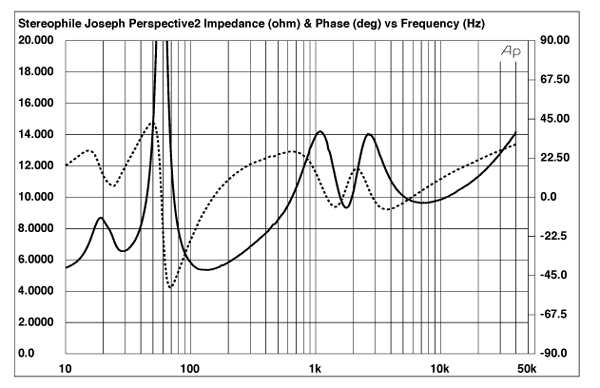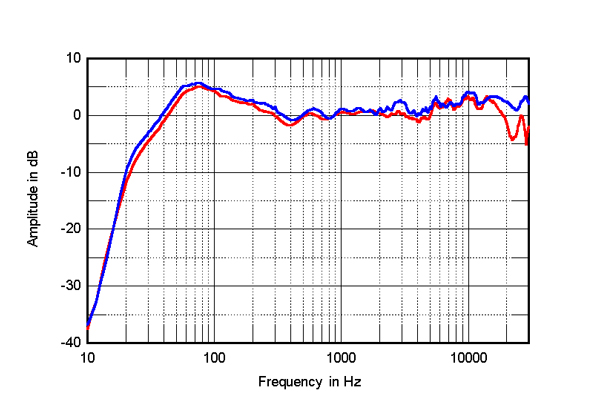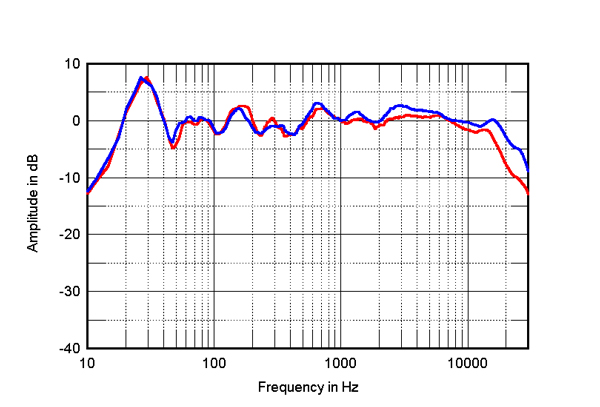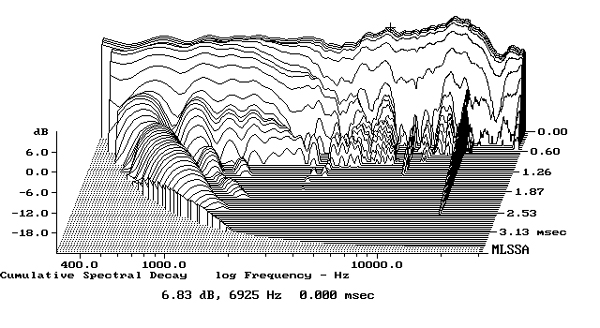| Columns Retired Columns & Blogs |
Does the 13 000$ big ones get you the speakers, and that giant violin?
Five years ago, in our July 2014 issue, I reviewed Joseph Audio's Perspective loudspeaker, a reflex-loaded, floorstanding, two-way design with two SEAS Excel magnesium-alloy–cone woofers and a SEAS Excel Millennium tweeter using a 1" Sonatex, impregnated-fabric dome. I summed up my thoughts by writing: "The Perspective is definitely a full-range loudspeaker, with impressive low-frequency extension and weight for a speaker with a relatively small footprint. It is also one of the more beautiful-looking speakers I have had in my listening room. . . . I can confidently recommend the Joseph Perspective. It's a lot of high-performance loudspeaker in a beautiful, modest-sized, domestically appealing package."
Five years to the day after Jeff Joseph had set up those Perspectives in my room, he was again visiting, this time with a pair of Perspective2s. The new speakers look identical to the old. A relatively small, beautifully finished tower, it still uses the SEAS tweeter, but the 5.5" woofers are now from SEAS's new Excel Graphene series. Graphene is a superstrong allotropic form of carbon—diamond is another, more familiar allotrope—that is related to graphite and consists of a single layer of carbon atoms arranged in a hexagonal, two-dimensional lattice. For the new woofers, SEAS has coated its cast magnesium-alloy cones with a graphene-based "nanomaterial" and, according to the Norwegian manufacturer's white paper, the result is a light, stiff diaphragm that is also well-damped—exactly what is required for a woofer cone.
In 2013, when it was introduced, the Perspective cost $12,999/pair; the Perspective2 costs $14,999/pair. The new speakers' serial numbers were P-0092L & R; my samples of the original Perspectives were P-0001L & R. I set up the new speakers exactly where the original Perspectives had sounded optimal: the left speaker's woofers were 28" from the LP cabinets that line the nearest sidewall, the right speaker's woofers 38" from the bookcases facing that wall. Both front baffles were 74" from the wall behind them, and the speakers were not quite toed in to the positions of my ears. The Perspective2s had the foam liners fitted to their reflex ports, which gives a slightly overdamped woofer alignment that Jeff Joseph feels will give the best combination of bass control and extension.
In my original review, I had found that the Josephs worked best with Pass Labs XA60.5 monoblocks. Those amplifiers had long since been returned to the manufacturer, so throughout my auditioning I drove the new Perspectives with the Lamm M1.2 Reference monoblocks that I reviewed in April 2012. Source was either the new dCS Rossini SACD/CD transport I reviewed in the May issue or my Roon Nucleus+ server sending data to the dCS Rossini or PS Audio DirectStream D/A processors. For most of my auditioning, I used Jeff Joseph's recommended Cardas Clear speaker cables. I also used AudioQuest K2 speaker cables, which gave the presentation a little more top-octave air.
With the Cardas-connected Lamms, the Josephs produced the same wide sweep of full-range sound and tangible stereo imaging that had so impressed me with the original Perspectives. The low frequencies were still rich, but perhaps the articulation was even better. Of course, it is impossible to make a definitive statement five years after I last heard the earlier speakers in my room, with different source and amplification components, but the reflex-loaded Perpective2 did rival sealed-box systems in this regard.
In my 2014 review, I had found the Josephs to be unforgiving of poor-quality recordings, which I ascribed to the speaker having a slight emphasis in the presence region. A recording I had found not to sound as good as I had wished with the original Perspectives was Beck's Morning Phase (24-bit/96kHz ALAC files, Capitol/HDtracks). While I love this album, every time I played it with the original Perspectives, I wanted to turn the volume down. That was definitely not the case with the Perspective2s. I could play "Heart is a Drum" at an SPL of 97dB(C) (Studio Six Digital SPL app on my iPhone, slow ballistics) without any sense of overload either from the speakers or from my ears. Turning to those superbly dynamic kickdrum samples on Cornelius's "Fit Song" (16/44.1k ALAC file, ripped from Sensuous: la musique du 21° siécle CD, Everloving/Warner Bros. EVE016), they punched the air in front of the speakers. When the kickdrum was doubled with synth dropped-bass notes, I was astonished by how much clean, low-frequency energy four 5.5" woofers could pump into my room.
With the Perspective2's combination of clean dynamics and rich, well-defined low frequencies, orchestral music was well-served. The big tune at the start of the first movement of Elgar's Symphony No.1 (Sir Adrian Boult conducting the LPO, of course, 16/44.1k ALAC files ripped from CD, EMI Classics 64013), with its pulsing bass line, sent shivers down my spine. And at the work's climax, when this sublime melody reappears in all its glory at the end of the fourth movement, overlaid by rushing strings and punctuated by percussion, I was again impressed by the Josephs' ability to play loud but without the sound becoming harsh or the small details of the scoring being blotted out.
Small-scale music was also well-served. As I write these words, I am listening to Richard Egarr and the Academy of Ancient Music's performance of Bach's Brandenburg Concerto No.6 (24/88.2k ALAC files, Harmonia Mundi HMU 807461.62. footnote 1). The Perspective2s maximally differentiated the character of the low-pitched (A=392Hz) baroque instruments, yet without adding undue emphasis to things like the rosin on the viola soloists' bows.

Turning to the Perspective2's measured performance, my estimate of the new speaker's voltage sensitivity was 83.6dB(B)/2.83V/m, which is within experimental error of the original Perspective's 84dB. This is low, but the Perspective2's plot of impedance magnitude and electrical phase against frequency (fig.1) suggest that the speaker is an easy load for the partnering amplifier to drive. However, while the Perspective's minimum magnitude was 6.27 ohms at 135Hz, the Perspective2's minimum was a little lower, at 5.36 ohms at 139Hz. The bass impedance peak was also greater, at 34.4 ohms at 59Hz compared with 15.6 ohms at the same frequency for the original speaker. With the foam liner, the reflex port on the rear panel was still tuned to 29Hz, and the crossover between the upper woofer and the tweeter is still set at 1.8kHz. (The lower woofer rolls off earlier than the upper one.)

Below 2kHz, the new speaker's quasi-anechoic response averaged across a 30° horizontal window on the tweeter axis at 50" (fig.2, red trace) is very similar to that of the older Perspective (fig.2, blue trace). However, the Perspective2 has a little less presence-region energy.

This difference may look small, but when you look at the spatially averaged responses at the listening position for the two speakers (footnote 2), the '2 has appreciably less energy in-room between 1kHz and 6kHz, which correlates with my finding the new speaker more tolerant of bright recordings than the older one. All three drive-units are still connected in positive acoustic polarity, and the Perspective2's cumulative spectral decay plot (fig.4) is as clean as the original's.

The new edition of Joseph Audio's Perspective is a superbly well-balanced loudspeaker that gave me extended hours of listening pleasure. It may cost $2000/pair more than its predecessor, but I recommend it even more highly than I did the original.—John Atkinson
Footnote 2: To make this measurement, I average 20 1/6-octave–smoothed spectra, taken for the left and right speakers individually with an Earthworks QTC-40 microphone, using a 96kHz sample rate, in a rectangular grid 36" wide by 18" high and centered on the positions of my ears.

Does the 13 000$ big ones get you the speakers, and that giant violin?

JA wrote, "...in fig.3, the upper woofer crosses over to the tweeter at a slightly lower frequency than the specified 2kHz, with a steep rolloff broken by resonant modes at 6.2 and 9kHz. These are well suppressed by the crossover..."
What I think we are seeing at 6.2kHz in your measurement is not a modal breakup resonance of the diaphram, but rather is the low pass crossover response above the notch at ~3.8kHz. The peak you measured at ~9kHz is more characteristic of the modal breakup resonance of Seas' Excel W15 family of woofer diaphrams.
The low pass crossover displays characteristic effects of an elliptical filter that combines a notch and low pass, with the notch steepening the intial rolloff of the low pass. For a description of this take a look at Albert Neville Thiele's US patent 6854005.
http://www.google.com/patents/US6854005

The magnesium woofer without a filter has resonances as JA correctly noted at 6.2 and 9kHz, but the woofer's highest peak is actually at 4.9kHz! (about 5dB above the 6.2kHz resonance). JA's measurements confirm that the resonances are well-supressed.

I have not heard this particular JA speaker. I have heard the JA Pulsar at an audio exhibition. JA speakers are out of my price range, but it was a privilege to hear the Pulsar.
The diminutive Pulsar projects an enormous soundstage that simply belies its size, and exceeds that of some larger, dare I say floorstanding, speakers. The build quality of these speakers is something that you have to see in person to appreciate fully, though they look great in this article, too.
The top-end Seas drivers used in these speakers are heartily capable, and maintain their composure, even at the highest volumes. They ably handle powerful amplification (I heard them with Hegel integrated amplification).
JA Speakers are fine products. I hope those interested get a chance to hear these speakers.